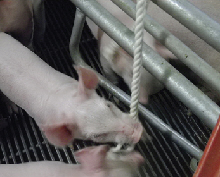



Increasing Creep Feed Intake by Stimulating Exploratory Behaviour Using Enrichment
Providing pigs with a large feeder so they could eat together appeared to attract the pigs more than rope as an enrichment toy in this experiment at the Prairie Swine Centre. Authors Yolande Seddon and Jennifer Brown noted in the Centre's annual report 2013-14 that neither feeder size nor enrichment affected growth rate except in the short term, however.Summary
This project examined whether increasing exploratory behaviour in piglets by providing enrichment in the farrowing pen can stimulate creep intake in piglets. If successful, this concept would be a simple way to reduce stress at weaning and increase growth rates.

Four treatments were tested in a 2×2 factorial design comparing presentation of creep in a standard feeder (SF) or a large tray feeder (TF) to encourage social interaction around the creep, combined either with enrichment (E) or without enrichment (C). Enrichment consisted of cotton ropes hung in the farrowing pen.
Results found that feeder type rather than enrichment increased the frequency of piglet visits to the feeder, with a greater frequency of visits to the TF on days 12 and 26 of age. Litters supplied with the TF also had a greater daily creep disappearance. However, litters supplied with the SF had a greater birth to wean average daily gain (ADG).

After weaning, piglets with the SF and enrichment had a significantly greater growth check within the first 24 hours of moving into the nursery, while the ADG of piglets in all other treatments did not differ.
At weaning, groups that received a TF did not show a negative ADG in the first 24 hours post-weaning, while groups with the SF had negative ADG values for this period. There were no treatment differences in ADG values for any other time period.
The increased creep disappearance found with the TF suggests piglets were interacting with the creep. However, birth-to-wean growth rates did not reflect any benefits of increased creep consumption, suggesting that feed wastage may have been greater with the TF.
The authors conclude that providing pigs with a larger feeder that encourages social feeding and rooting had a greater influence than rope enrichment at attracting them to creep feed.
Effects of the TF on feeding behaviour needs to be studied further to understand how exposure to the TF in farrowing prevented weight loss on day 1 post weaning as was found in groups provided the SF.
Introduction
Weaning is a highly stressful time for piglets, with multiple significant changes occurring simultaneously (change in diet, environment, mixing with unfamiliar piglets). Weight loss and increased cortisol levels have been observed for the first few days after weaning, indicating this is a stressful event for piglets. Inadequate feed intake in the first two days after weaning, in combination with the stress of weaning, decreases piglet performance, resulting in increased disease susceptibility and mortality through changes in metabolic and immune function.
Promoting solid feed intake before weaning by provision of creep feed familiariss the piglets with solid feed. Piglets that consume creep show better feed intake and improved growth rate in the critical weaning and post-weaning period. However, previous work conducted at the Prairie Swine Centre shows that the amount of creep feed consumed is often very low, and a high number of piglets fail to eat creep.
It is important to identify convenient and effective ways of increasing the volume and consistency of creep feed consumption by piglets.
Previous research by others has determined that the amount of creep consumed by piglets can be increased by provision of a specially designed feeder that encourages exploratory interaction around the feeder. It is known that piglets raised outdoors are quick to consume starter feed and will often ingest soil and plant material while exploring their environment. However, piglets reared indoors do not have the same opportunity for exploration.
This study builds upon current knowledge to investigate the effects of provision of environmental enrichment within the farrowing pen and nursery on exploratory behaviour, frequency of visits to the creep feeder, creep consumption and piglet growth rate. If simple enrichment can increase creep feed consumption in piglets, this could result in reduced stress at weaning and better growth in the post-weaning period.
This work investigated whether pre-weaning creep consumption can be increased through stimulating exploratory behaviour in piglets, and whether this is best achieved through provision of enrichment (E) to increase pen exploration, or by presenting creep in a large shallow feeder to facilitate synchronised feeding among littermates. Piglets were observed and weighed for two weeks after weaning to determine the impact on weaning stress and growth rate.
Specific objectives of the project were to determine:
- If providing enrichment, and/or a large shallow tray feeder in the farrowing pen results in increased exploration of creep feeders and increased creep consumption or improvement in pre-weaning growth rate.
- If the continued provision of enrichment in the nursery and/or having had a larger tray feeder in farrowing results in increased feed consumption or improvement in piglet growth during the first two weeks in nursery.
Experimental Procedure
Four treatments, (n=7 litters per treatment) were studied:
- T1: Creep provided in a standard feeder (SF)
- T2: Creep provided in SF, with enrichment (E)
- T3: Creep provided in a large tray feeder (TF)
- T4: Creep provided in TF with E. Creep feed was offered to all litters from 10 days aft er birth until weaning (28 days).

For enrichment, strips of cotton rope were hung in farrowing pens from five days after birth until weaning. Piglet weights and creep consumption per pen were recorded weekly. Behaviour was recorded on four litters per treatment for eight hours (8am to 4pm) on days 12, 19 and 26, and again on days 1, 5 and 10 post-weaning. Behaviour of the whole pen was recorded, as well as the individual behaviour of four marked focal pigs.
Video footage was scanned at five-minute intervals and the number of piglets interacting with the feeders (head in feeder) recorded, and for E treatments, the number of piglets interacting with E (snout touching, or chewing E). Pen ADG and creep consumption were calculated. Data were analysed to determine the individual and interactive effects of feeder type and provision of enrichment.
Results and Discussion
Piglet behaviour
Within the farrowing pen, piglets provided with rope enrichment were found to make on average 11 visits to the enrichment per day. However, provision of a tray feeder, rather than enrichment resulted in a greater frequency of piglet visits to the creep (Table 1) on day 12, with a tendency for a greater number of visits to the feeder on days 19 and 26.
There was a tendency for a greater number of piglets per visit at the tray feeder on day 12 before weaning, but no differences thereafter between the treatments (Table 2). Typically, only one piglet was seen at the feeder at a time.
| Table 1. Average total frequency of visits per litter made to the creep over eight hours (8am-4pm) when presented in a SF or TF |
||||
| Feeder type | ||||
|---|---|---|---|---|
| Day | SF | TF | Pooled SEM | P |
| 12 | 1.3 | 6.0 | 1.2 | <0.05 |
| 19 | 3.8 | 15.0 | 3.6 | 0.052 |
| 26 | 5.3 | 16.4 | 4.1 | 0.086 |
| Table 2. Average total number of piglets observed visiting the feeder at once | ||||
| Feeder type | ||||
|---|---|---|---|---|
| Day | SF | TF | Pooled SEM | P |
| 12 | 0.6 | 1.1 | 0.2 | 0.06 |
| 19 | 1.1 | 1.2 | 0.1 | NS |
| 26 | 1.2 | 1.2 | 0.1 | NS |
Creep intake and growth rate
The addition of rope enrichment had no effect on the creep disappearance or average daily gain in the pre-weaning period. Litters supplied with the tray feeder had a greater daily creep disappearance (SF 86g; TF 163g; SEM 20; P<0.05), than those given the standard feeder.
However, litters provided with the standard feeder had a greater piglet birth-to-wean average daily gain in the pre-weaning period (SF 0.25kg; TF 0.22kg; SEM 0.01; P<0.05).
On day 1 after weaning, piglets with the standard feeder and enrichment had a significantly greater growth check within the first 24 hours of moving into the nursery, while the ADG of piglets in other treatments did not differ.
Groups that received a tray feeder did not show a negative ADG in the first 24 hours after weaning, while those with standard feeders had negative ADG values for this period.
There were no differences in treatment between the ADG values for any other time period (Table 3). Further analysis will be done on behavioural data in the nursery to examine relationships between behaviour and growth.
| Table 3. Growth rate (ADG in kg) per pig across treatments | ||||||
| Treatment | ||||||
|---|---|---|---|---|---|---|
| T1 | T2 | T3 | ||||
| Growth period: | C | ESC | TC | T4:TEC | Pooled SEM | P |
| Birth to wean | 0.26 | 0.23 | 0.21 | 0.22 | 0.014 | NS |
| Wean to day 14 nursery | 0.22 | 0.16 | 0.24 | 0.25 | 0.03 | NS |
| Growth day 1 after weaning | -0.04* | -0.22 | 0.16 ab | 0.18 ab | 0.11 | 0.05 |
| ADG day 5 nursery | 0.22 | 0.23 | 0.16 | 0.16 | 0.02 | NS |
| ADG day 14 nursery | 0.35 | 0.34 | 0.34 | 0.38 | 0.02 | NS |
The provision of rope enrichment in the farrowing pen did increase the exploratory behaviour of piglets. However, provision of a larger feeder that could encourage social feeding and rooting, appeared to have a greater influence on attracting piglets to creep feed. This was demonstrated by the increased frequency of visits to the feeder when litters were provided with tray feeders.
This feeder differed from conventional round creep feeders, as it was long and shallow (22cm × 33cm), allowing several piglets to investigate the feeder simultaneously. In comparison, the standard creep feeder is smaller, and round (24cm in diameter), with divisions to discourage rooting and reduce wastage.
Pigs are social feeders and tend to synchronise feeding behaviour. The accessibility of the tray feeder may help to facilitate synchronised feeding. However, the results show no difference in the average total number of piglets at the feeder per visit, suggesting the tray feeder did not increase synchronisation of feeding. Instead, the tray feeder may simply facilitate investigation of the feeder, being shallow and large, piglets can actively root in the creep.
The increased creep disappearance found with tray feeders suggests piglets were interacting with the creep. However, birth-to weaning growth rates did not reflect any benefits due to increased creep consumption, suggesting that the tray feeder may have resulted in greater wastage. In contrast, piglets provided with creep in the standard feeder had the greatest ADG in farrowing.
In the period immediately after weaning (day 1), piglets that received the tray feeder performed better, showing no negative growth check, and maintaining a positive ADG compared to piglets that had been given standard feeders, and lost weight.
There was no effect of enrichment on the piglet performance post weaning. In fact, the piglets that received the standard feeder and the rope enrichment had a significantly greater growth check on day 1 post-weaning than did the piglets provided with the tray feeder, with or without enrichment.
Further work will be conducted to complete analysis of the data. In particular, analysis of piglet behaviour post-weaning will be done to determine if feeding behaviour can help to explain the reduced growth check that was seen in groups provided with the tray feeder.
The researchers speculate that providing creep in the tray feeder encouraged rooting and exploration within the farrowing pen, and this may have transferred to an increased exploration and consumption of feed in the nursery.
Conclusion
Providing piglets with rope enrichment, and/or presenting creep feed in a large, shallow tray feeder did not increase creep consumption or growth rate before or after weaning.
However, litters given a tray feeder showed a higher frequency of visits to the feeder than those provided with the standard feeder, and did not have a negative growth check post-weaning.
This lack of post-weaning growth check observed in piglets given a tray feeder pre-weaning is an area to explore further.
Further work should be done to explore other avenues to stimulate feeding behaviour, increase creep consumption and reduce weaning stress in piglets.
Acknowledgements: The authors gratefully acknowledge specific project funding for this
study provided by the Canadian Agricultural Adaptation Program (CAAP). Strategic program funding to the Prairie Swine Centre was provided by Sask Pork, Alberta Pork, Manitoba Pork Council, Ontario Pork, and the Saskatchewan Agricultural Development Fund.
April 2015








